
What’s SHOOT THE MESSENGER?
Well, AICN COMICS: SHOOT THE MESSENGER is your weekly one stop shop for comic book -EWS. What’s comic book –EWS? Well, it’s our hodge podge of everything not reviews here at AICN Comics. Sure you can find out the @$$Holes’ critical opinions of your favorite books every Wednesday at AICN Comics. But here, you’ll find special reports such as previews, interviews, special features, and occasionally news gathered here from our online brethren at Newsarama, CBR, Wizard, etc. Sure those guys are the best at reporting news as it breaks. Click on the links for the original stories. This column cuts the crap to run down all the vital information for those of you who don’t follow it as it comes in, and serves it all up with that special ingredient of @$$y goodness.
Good Morning, Talkbackers! Ambush Bug here. We’ve got an extra special column this bright and shiny Monday morning. We’ll have an AVATAR contest, an interview with myself from my book signing for my new comic THE TINGLERS and Matt Adler’s interview with LENORE’s Roman Dirge, plus a whole slew of previews in an extra special Tuesday edition of Shoot the Messenger tomorrow.
But this column is going to be dedicated to a trio of very cool exclusives for you all. First we have a pair of exclusive interviews with J.M. Straczynski and Geoff Johns concerning the just announced SUPERMAN: EARTH ONE and BATMAN: EARTH ONE graphic novels!

This morning, DC announced a pair of huge 2010 releases: SUPERMAN: EARTH ONE and BATMAN: EARTH ONE, two graphic novels spotlighting the most powerful heroes of the DC Universe, with their first years and earliest moments retold in a standalone, original graphic novel format. SUPERMAN: EARTH ONE will be written by J.M. Straczynski and drawn by Shane Davis. BATMAN: EARTH ONE will be written by Geoff Johns with art by Gary Frank. Read more about this one from The Source. I had a chance to talk with both Straczynski and Johns about these exciting new books. What secrets will be told? Does this major announcement mean the end of monthly comics? These questions and more will be answered. Read on…
Bug and JMS talk SUPERMAN: EARTH ONE!
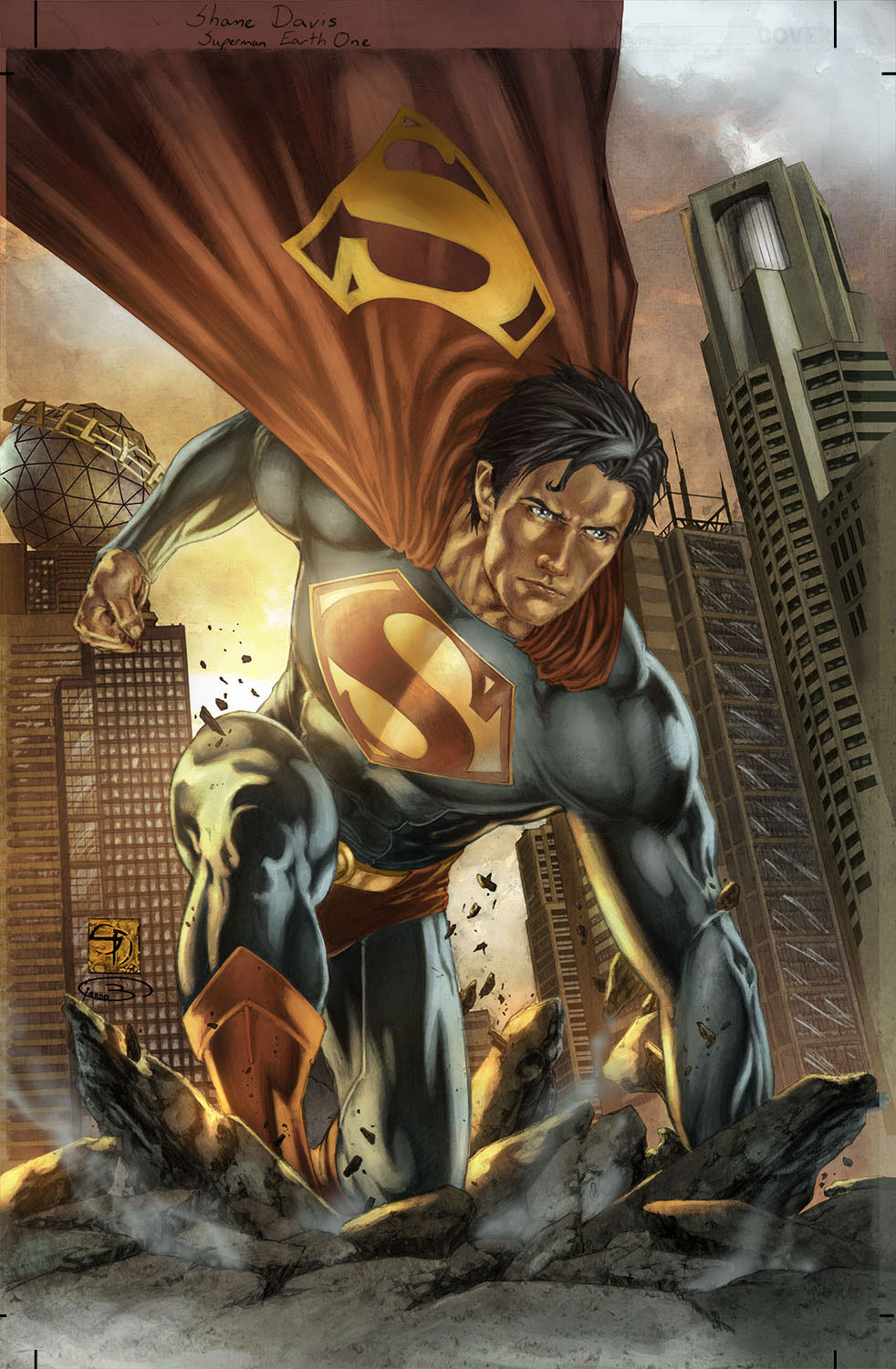 AMBUSH BUG: Tell me a little bit about the premise behind SUPERMAN: EARTH ONE.
AMBUSH BUG: Tell me a little bit about the premise behind SUPERMAN: EARTH ONE.
J. Michael Straczynski (JMS): There's this notion, which has really become a kind of accepted cliché, that as soon as you get powers, you put on a superhero (or super-villain) costume and you're off to the races. But logically, there would have to come a moment when you have to decide if you actually want to do that, or if you should do that. It's that moment in the Garden of Gethsemane where you have to decide if you want to endure everything that's going to happen to you if you decide to expose yourself.Clark comes to Metropolis in his 21st year to decide what he really wants to do. And this is someone who can be anyone, do anything. If he keeps his background secret, as he's done for the preceding 21 years, he can be the best athlete the world has ever known, he could be the next Stephen Hawking, could take away the golf crown from Tiger Woods, create patents that could earn billions. He can finally step out of the shadows and into the light.
By contrast, if he chooses to become Superman, then Clark must live forever in the shadows, dedicated to a life of service and self-sacrifice that could eventually get him killed. That's a hard choice for anybody to make, let alone a 21 year old kid who wants to look after his mom and is lured by the idea of money and success and fame. So the story is about Clark's Gethsemane moment, when he has to finally make that choice, why he makes it, and what follows after.
Against this backdrop, we flash back to his life growing up in Smallville, so we can see how the Kents helped mold him and protect him and get him to a point in his life where he can finally make this most difficult of choices.
BUG: How is your take on the younger years of Superman going to be different than previous takes on his origin?
JMS: This is probably one of the most often told and re-told stories in comics history, so you have to be careful to preserve what's established while trying to find areas where you can bring a fresh approach. But I'll be straight up with you: I'm not here to change his story into something it was never intended to be so that I can "make my mark" on the character. It's about respecting the character and his origins. Especially for me, since Superman has always been my number one icon growing up as a kid. Coming from poor surroundings and circumstances where everybody says "forget this idea of being a writer, guys like you who come from nothing always end up at nothing," Superman was what I held onto, the idea of someone who could do anything. My house is filled with enough original Superman artwork, memorabilia and other stuff to constitute a museum. It's probably one of the biggest Superman collections on the Western Seaboard, not because of the collecting instinct, but because that's how much the character has meant to me over the years.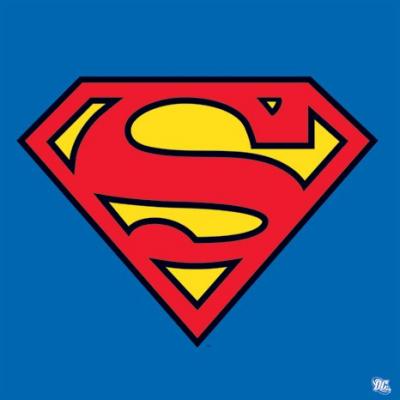 (True story: I was at Chicago Comic-Con a number of years ago, standing in the dealer's room, when some guy grabbed a bunch of expensive items off a table and made a run for it down the aisle, being chased by the owner of the table. Everybody in the aisle did a fast fade, parting before this guy like the Red Sea. I brought the mofo down and the two of us held him for the police. The con organizer later came up to me and said, "Why'd you do that? He was half your age and twice as big, you could've been hurt." I pointed to where I'd been standing, in front of a ten-foot-tall cutout of Superman. "How could I stand under that, in front of him, and do nothing?" I said.)
(True story: I was at Chicago Comic-Con a number of years ago, standing in the dealer's room, when some guy grabbed a bunch of expensive items off a table and made a run for it down the aisle, being chased by the owner of the table. Everybody in the aisle did a fast fade, parting before this guy like the Red Sea. I brought the mofo down and the two of us held him for the police. The con organizer later came up to me and said, "Why'd you do that? He was half your age and twice as big, you could've been hurt." I pointed to where I'd been standing, in front of a ten-foot-tall cutout of Superman. "How could I stand under that, in front of him, and do nothing?" I said.)So to the point of your question, what I'm trying to do is to dig in to the character and look at him through modern eyes. If you were to create the Superman story today, for the first time, but keep intact all that works, what would it look like? As a fledgling writer I used to love going to see productions of Shakespeare because what would often be done would be to take that original play and move it forward in time. So you could have “Two Gentlemen of Verona” set in pre-WW2 Italy...you could have a female Hamlet...or as was recently produced for film, “Richard III” set in a corollary for Nazi Germany. And suddenly the lens through which you view those stories, those plays, colors and changes how you perceive them without changing anything essential.
Here, of course, we're doing more than that because we're not sticking to a script, but the idea is much the same. So in the case of Superman, you take all those elements that work, and infuse them with a modern sensibility, how it would be written today, this minute, if it had just been created for the first time. If I have any one particular strength as a writer, it's taking someone of massive power and making them relatable, sympathetic and vulnerable while not taking an inch away from that incalculable power.
BUG: Are there aspects of Superman's origin that you purposefully left out for the sake of your story?
JMS: The only substantial thing I'm leaving out is the notion of a Superboy. Here, the first time Clark puts on that uniform, it really is his first time.In reflecting further on the question of changes, probably one of the most changed characters is Jim Olsen, and the most changed atmosphere is that of the Daily Planet. Having worked as a journalist for nearly ten years, I know what a news room is supposed to feel like, and my one ongoing complaint about comics set in those environments is that you (or I) could tell that the writers had never actually worked for a newspaper.
And in any newspaper, the one guy who is the most dangerous guy to stand next to is the photographer, because they'll go anywhere and do anything to get the shot. I recently saw footage where a press photographer was at one of those races that go through city streets, and a car spun out and came right at him. He kept taking pictures as the back end hit the wall to his right, spun out, and the front hit the wall to his left, barely missing him by inches. He never once stopped snapping photos. A good newspaper reporter keeps shooting no matter the danger, so I'm bringing that aspect into Olsen.
The rest of the staff look, act and talk like actual reporters now, and that's a lot of fun. And when we join our story, the Daily Planet is on the downward slide...it's where new reporters come to learn and old reporters come to die. It's what begins to happen in the aftermath of Superman's appearance that starts to reverse their fortunes.
BUG: How do you deal with the delicate tightrope walk of telling stories that matter vs. not straying so far from the status quo that you don't recognize these iconic characters anymore?
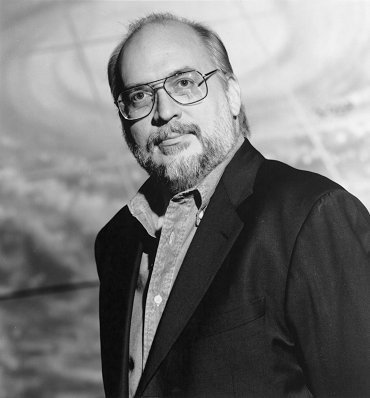 JMS: I think it's a matter of respect and keeping the character first. Again, you don't change things just so you can say "I changed that." You have to ask if it proceeds from character. So for instance, one of the elements of the story is the fact that growing up, Clark would have been even more of an outsider than we've seen previously. Every kid gets in schoolyard fights, but Clark would have had to walk away or just take the punches, because if he slipped for even a second, he could kill the other kid. This would have gotten him a reputation as a coward, a weirdo, and he'd have to hear that every day in the schoolyard...and the one thing you know as a kid is that you don't hang with the cowards or the weirdos. So he would've lived a very solitary, rough, and very controlled life, because even a brief lapse could have disastrous consequences. We see a very real sense of isolation in him, which informs his arrival in Metropolis which represents the first time when he can choose the life he wants, rather than having to endure the life he had to endure.
JMS: I think it's a matter of respect and keeping the character first. Again, you don't change things just so you can say "I changed that." You have to ask if it proceeds from character. So for instance, one of the elements of the story is the fact that growing up, Clark would have been even more of an outsider than we've seen previously. Every kid gets in schoolyard fights, but Clark would have had to walk away or just take the punches, because if he slipped for even a second, he could kill the other kid. This would have gotten him a reputation as a coward, a weirdo, and he'd have to hear that every day in the schoolyard...and the one thing you know as a kid is that you don't hang with the cowards or the weirdos. So he would've lived a very solitary, rough, and very controlled life, because even a brief lapse could have disastrous consequences. We see a very real sense of isolation in him, which informs his arrival in Metropolis which represents the first time when he can choose the life he wants, rather than having to endure the life he had to endure.BUG: How does SUPERMAN: EARTH ONE fit in with current continuity? The name suggests that it could be either part of it or an all new start from square one for the character.
JMS: At this juncture, the book operates outside DC continuity. At some point way, way down the road, some of that may be folded in, but again that's a long ways away.BUG: It seems there is a pretty even split when it comes to whether someone is a Batman fan or a Superman fan. What is it about the character of Superman that appeals to some but not others?
JMS: I think it's a difference between power fantasies and revenge fantasies, with Superman more the former, and Batman more the latter. Not to belabor the previous point, because we all have our childhood horror stories, but I grew up in the mean streets of Newark and Paterson and some of the poorer parts of other towns. We moved 21 times in my first 17 years. Guys like me didn't become writers, they ended up pumping gas or working in machine shops. It was a dead-end lifestyle filled with no. So on the one hand, there was no one I wanted to get revenge against...I just wanted a chance to be somebody, a chance to learn to fly, and to become someone who couldn't get hurt. So I latched on to Superman at a very early age. I've said it before, and it's true: most of my morality I learned from Superman. One of my very earliest memories is an image from a Max Fleischer Superman cartoon where he has his cape over Lois, protecting her from molten metal. I searched for that image for decades before I found it and it's one of the first things you see when you enter my home...that and a mountain of Alex Ross and Curt Swan artwork, and The Triptych: a sketch of Superman signed by Siegel and Shuster, with an autograph by George Reeves tipped into it.BUG: Can you tell me a little bit about the art in this one and how you worked with artist Shane Davis?
JMS: Because I tend to write from emotion to action, I live or die by the degree to which the artist is able to express emotion. So when Dan DiDio and I began the process of finding an artist, that skill was number one on the list. As soon as I saw Shane's art, I knew he would be right for this, because he can not only get that degree of expressiveness, but he's also really great on action and composition. There's an insane amount of detail in his work. We had a lot of back-and-forth in terms of character design that led to some really cool stuff.BUG: How do you respond to criticism you've received for delayed titles that you've penned? Was it easier for you to write in this graphic novel format than the monthly grind?
 JMS: Let me dive into this for a second, because this is a sore point with me. I was on AMAZING SPIDER-MAN for over eight years, and with only a couple of small glitches that book came out like clockwork. BULLET POINTS: on time. SILVER SURFER REQUIEM: on time. MIDNIGHT NATION: on time. BRAVE AND THE BOLD: on time. When I took on THE TWELVE, I wanted to do it the same as BP and SSR: let me write it all the way through, get most of the art done, then announce it, because in particular I was concerned that there might be some conflicts in scheduling not just with me but with the artist. But when PROJECT SUPERPOWERS was announced, the powers that be at Marvel decided to go ahead before it was ready, and what I was afraid would happen, happened. He got busy, I got busy, then he got busy again, then I got busy again, and it fell off the grid. (Note: the last scripts will be in by year's end.) With Thor, I'll take the rap for a couple of delays, but Marvel also delayed the book to buy time to find another artist. Between the time I finished the script for the last issue, for instance, and its publication, almost four months went by. I have the timestamp on the file to prove it. That ain't my choice, but I get the rap for it.
JMS: Let me dive into this for a second, because this is a sore point with me. I was on AMAZING SPIDER-MAN for over eight years, and with only a couple of small glitches that book came out like clockwork. BULLET POINTS: on time. SILVER SURFER REQUIEM: on time. MIDNIGHT NATION: on time. BRAVE AND THE BOLD: on time. When I took on THE TWELVE, I wanted to do it the same as BP and SSR: let me write it all the way through, get most of the art done, then announce it, because in particular I was concerned that there might be some conflicts in scheduling not just with me but with the artist. But when PROJECT SUPERPOWERS was announced, the powers that be at Marvel decided to go ahead before it was ready, and what I was afraid would happen, happened. He got busy, I got busy, then he got busy again, then I got busy again, and it fell off the grid. (Note: the last scripts will be in by year's end.) With Thor, I'll take the rap for a couple of delays, but Marvel also delayed the book to buy time to find another artist. Between the time I finished the script for the last issue, for instance, and its publication, almost four months went by. I have the timestamp on the file to prove it. That ain't my choice, but I get the rap for it.With all that being said, for me, it's best to do it then announce it, so there are no delays. So when DC came to me about this project, I felt it was important to again say nothing specific about it until it was nearly done. As I write these words, the script is very close to being finished (we're talking a book of well over a hundred pages), and we've got oodles of art finished.
BUG: The graphic novel format has been a preferred reading experience for a growing number of fans. Trade-waiting is a pretty common term I hear thrown around these days. What do you think; does the release of such a high profile product in a graphic novel format signify the end of the monthly single issues?
JMS Not at all. It's like saying that the production of movies signifies the end of dramatic series TV. Each serves a different need, and fills a different niche. If there's anything that is signified by trade-waiting, it's that we need to write better stories. If a reader can wait until it's all done to buy it, then we're not doing our jobs right. We should be writing stories that the reader can't wait to buy as soon as the next installment hits the stands, and then at the end, wants to gather together for ease of re-reading. If a reader can wait it out, then we as creators need to re-evaluate our work. Seriously.BUG: Thank you for taking the time to answer these questions.
Bug continues the EARTH ONE goodness
with BATMAN: EARTH ONE writer Geoff Johns!
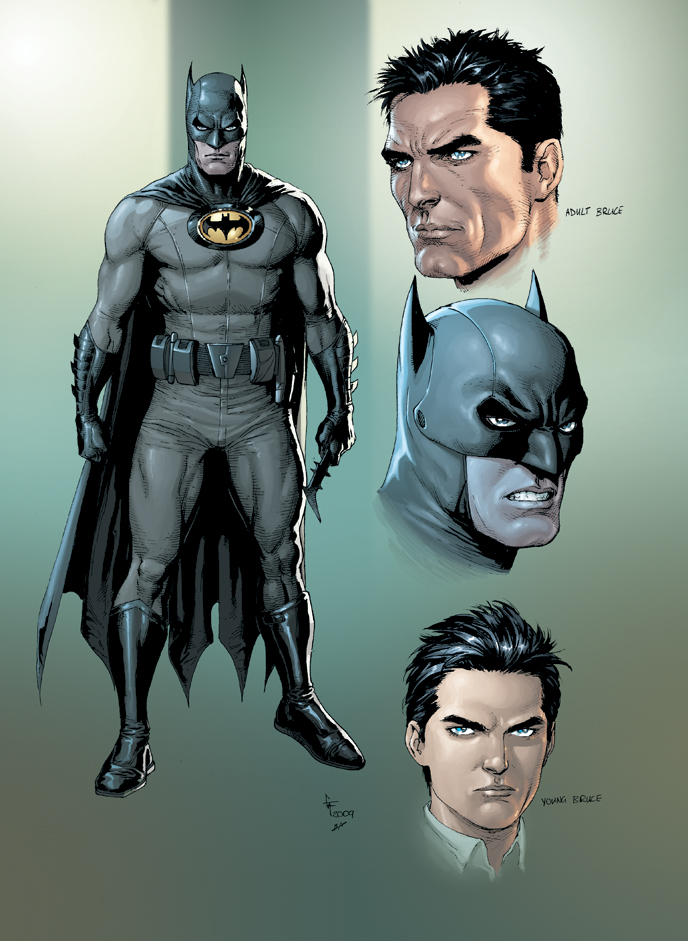
To read his work is to love his work. Geoff Johns has become THE man at DC with a track record of hits like few others. Geoff had a chance to answer some questions about the upcoming BATMAN: EARTH ONE graphic novel.
AMBUSH BUG (BUG): So what is BATMAN: EARTH ONE all about?
GEOFF JOHNS (GJ): It’s Gary Frank and I joining together to be a part of the first line of ongoing graphic novel series ever from the big two.BATMAN: EARTH ONE is more in line with the European idea of releasing chapters of an ongoing series in graphic novel form. We’re planning on doing two novels a year and set in this new universe, we’re getting unlimited creative freedom that we couldn’t have in current continuity.
When Dan Didio asked if Gary and I would be interested in something like this we were onboard immediately. We’re taking on Batman, and the world around him, and rebuilding it from the ground up.
BUG: How do you make an iconic origin like Batman's fresh and different than previous takes on the story?
GJ: Our Batman is a decidedly different Batman yet it is, of course, Bruce Wayne.I want to let the book will speak for itself, but Batman, Alfred, Detective Gordon, Arkham Manor, the twisted origin behind Gotham City, the Bat-Mobile and, of course, the world’s greatest group of villains are all a part of the world we’re creating. Some of it the characters will more closely resemble the classic interpretations while others will be wildly different. We’re introducing a lot of new characters and elements to this Batman.
The first graphic novel features an entirely new villain.
BUG: Apart from event books and maybe the occasional guest appearance or team book appearance, this is the first time I recall you doing a Bat book. What was it about this project that finally attracted you to Gotham?
GJ: Three words: “Gary Frank” and “freedom.” Obviously, I love long form storytelling. I gravitate to projects I can dive into and reinvent and add to, like Green Lantern. I’ve wanted to work on Batman, but I wanted to wait until the project was right. BATMAN: EARTH ONE allows Gary and I to break the restraints of any continuity and focus on two things: character and story. Add to that the idea of working on a line of graphic novels instead of being limited to twenty-two pages, it’s a challenge and I love a challenge.BUG: I know you're a multiverse freak. How does BATMAN: EARTH ONE fit in with current continuity? Is it another universe, an Ultimate/All Star style take, or something completely different?
GJ: All of the above.BUG: I've observed somewhat of a split between those who like Batman and fans of Superman. What is it about Batman that appeals to so many readers?
GJ: I think the grounded nature of Batman. And if there is one word that might sum up our version of Batman it’d be grounded.BUG: The Joker: insane or sane? And will he be showing up in BATMAN: EARTH ONE?
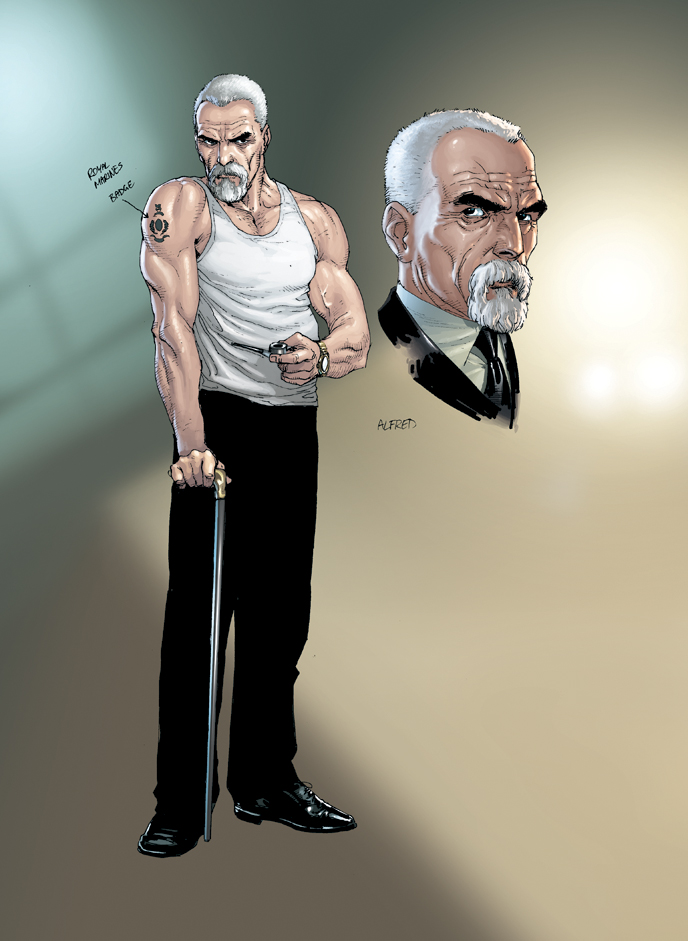 GJ: If anyone knows my work they know how much I love villains. I’ve been dying to crack into the best rogues’ gallery in comics for years. Eventually, yes -- you’ll see the Joker, but the first well-known villain we’ll be focusing on early in the BATMAN: EARTH ONE graphic novel series is the Riddler.
GJ: If anyone knows my work they know how much I love villains. I’ve been dying to crack into the best rogues’ gallery in comics for years. Eventually, yes -- you’ll see the Joker, but the first well-known villain we’ll be focusing on early in the BATMAN: EARTH ONE graphic novel series is the Riddler.BUG: Gary Frank has been one of my favorite artists since his INCREDIBLE HULK run. Can you tell us a little bit about how you and he collaborated for this project?
GJ: First off, Gary Frank is one of the greatest partners-in-crime a writer could ever ask for. The amount of thought, care and effort he puts into his work along with the brilliance of his talent makes him someone that I’m chaining myself to. My aspirations are nothing less than to work with Gary Frank until I’m dead.The fact is, Gary Frank is the single best Superman artist of this generation, but he’s actually a Batman guy. Before we started Superman, we’d talk about Batman at length. We’ve spoken about ideas for Batman since we started working on Superman together. We started brainstorming this project before it even started, discussing what we would do with Batman and where we would take him.
BUG: After doing this project, which do you prefer writing: monthlies or graphic novel sized stories?
GJ: Ask me again in five years.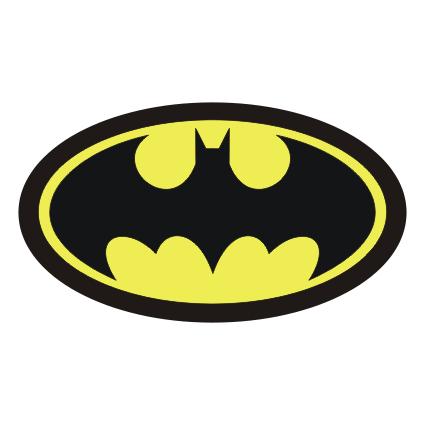
BUG: What does this graphic novel format say about where the industry is going? A lot of folks are waiting for trade these days. Is this the first step of DC dropping monthlies and cutting out the middleman and going straight to trade?
GJ: I don’t think it has to be the case with either or. Monthlies, graphic novel series, digital, etc. DC is exploring every avenue of publishing. It’s a changing market, but it’s an expanding and growing market, and I’m psyched to be riding the wave up front with Gary and Batman.Thanks, Geoff, for chatting with us.
Ambush Bug is Mark L. Miller, reviewer and co-editor of AICN Comics for over eight years and one of the original @$$holes. Check out his comic book shorts from Cream City Comics’ MUSCLES & FIGHTS VOL.3 and MUSCLES & FRIGHTS VOL.1 on his ComicSpace page. Bug was interviewed here and here at Cream City Comics and here and here about his latest comic from Bluewater Comics, VINCENT PRICE PRESENTS: THE TINGLER #1-2. Look for more comics from Bug in 2010 from Bluewater, including VINCENT PRICE PRESENTS WITCHFINDER GENERAL, ROGER CORMAN PRESENTS DEATHSPORT, and the just announced vampire miniseries NANNY & HANK (and check out Jazma Online’s new interview with Bug about NANNY & HANK here).
